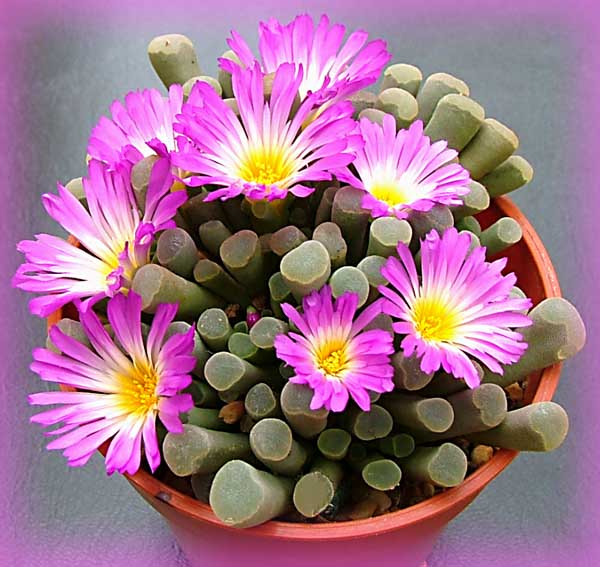
Growth Habits: This is one example of the plants known as the ‘window succulents.‘ Plants comprise a cluster of succulent leaves that have windowed tips. They have a short, thickened rootstock underground. Stems can become much reduced during periods of drought and the plants shrink in size as a result of moisture loss. They sometimes even disappear below the grit under adverse conditions, making them very difficult to find. The shrinkage is achieved by means of leaf cells arranged in columnar rows. When moisture is lost and the contents shrink, the tangential cell walls contract, drawing the plants deeper into the soil avoiding desiccation during the dry winter months or in times of drought.
Scientific name: Frithia pulchra
Family name: Mesembryanthemaceae (Aizoaceae)
Common names: bobbejaanvingers, glasies, toontjies, window plants and, perhaps most appropriately fairy elephant's feet.
Synonym:
Etymology: The genus Frithia was established by N.E. Brown (1925), a taxonomist based at Kew Herbarium. At that stage no species were assigned to this genus and only later was a full description of Frithia pulchra given (Brown 1926). It was named after Frank Frith (1872 - 1954), a railway services gardener stationed at Park Station, Johannesburg, who took the specimens to Brown at Kew while on a visit to London. Brown named Frithia in honour of the man who brought him the specimens. The specific epithet pulchra is derived from the Latin "pulcher" meaning beautiful.
Origin: Frithia pulchra grows exclusively in the summer-rainfall region of South Africa and has a restricted distribution. Populations of these miniature window plants occur in the Magaliesberg, from Hartbeeshoek to the Rustenburg Nature Reserve (North-West Province and in Gauteng), where higher altitudes are favoured.
Light: The plant will take as much light as you can give it, but fierce sunshine could ‘scorch’ the plant. In habitat the plant overcomes this problem by only having the leaf tips showing above the ground.
Compost: An open compost is essential and if the only pot available is a deep one fill the bottom half with coarse grit or gravel.
Water: Frithia is not shy of water and should be watered regularly during the growing season, but the water must be able to drain away quickly. Keep the plant dry in winter.
Flower: The single flowers are bright magenta with a white or light yellow centre and are 25 - 35 mm in diameter and are borne on very short stalks or are stalkless. The five sepals are unequal and closely resemble the cylindrical leaves. Petals number between 30 and 45 and usually have blunt, rounded tips.
Fruit: The fruits, as with many Mesembryanthemums are in the form of a capsule. These open when a drop of water fall on them and close again when they are dry (hygrochastic capsules), opening to allow the seeds to be released and closing until the next rainfall occurs to help with germination.
Min. temp: 50°F (10°C). Will take lower temperatures for short periods if kept perfectly dry.
Cultivation: This species grows in very shallow soils in its native habitat, therefore it is essential that it is watered carefully and the soil is never allowed to become saturated and sour.
Habitat: Frithia pulchra can be found growing on exposed rock plates, the roots anchored in cracks between the coarse quartzite. This substrate reaches very high temperatures in summer and may experience frosts during severe winters.
Comments: This is a beautiful and interesting plant and I have always had one in my collection. It is not a difficult plant to keep as long as the above rules are followed and will always reward you with a good show of flowers. It can be confused with the genus Fenestraria, but close inspection shows that they are markedly different even when not flowering. The flowers of the two genus are totally different and at flowering time they certainly cannot be confused with one another.










